Research Synergies between Sustainability and Human-Centered Design: A Systematic Literature Review
Abstract
1. Introduction
2. Materials and Methods
2.1. Main Research Topics Linking Sustainability and HCD
2.2. Network Visualization and Data Refinement
3. Results
3.1. Main Research Topics Linking Sustainability and HCD
3.1.1. Design Research Methods for Sustainability
- Finally, articles discussing the value of participation, e.g., [33], examine the contribution of bottom-up long-lasting design processes in increasing the quality of life of rural communities.
- Disciplinary and interdisciplinary issues related to design education. Articles grouped under this theme discuss the T&L pathways toward sustainability, the development of skills to tackle the complex scenarios related to it [37], experiments made to develop educational programs, innovative methods for aware teachings [38], and general reflections on the social side of design for sustainability, e.g., [39].
3.1.2. Health for a Sustainable Society
- Studies connecting health with HFE domain, where the attention is mainly focused on healthcare systems, e.g., [40], and on the design of ergonomically coherent solutions for health.
- Another group of works analyses the contribution of health research in two research trajectories. The first one discusses design-led principles and research methods for the development of technology-led solutions for health [43], including services and toolkits [44], whilst the second one deals with creative methods for improving the adoption of health systems [45].
- The contribution of HCD in the development of smart age-friendly solutions, e.g., [46], seen as a media to improve the sustainable quality of life of elderly people, which ultimately mirrors a better life for all users.
3.1.3. Technological Contexts for Sustainable Innovations
- Four studies discuss the technological advances for human-centered sustainability in the industry sector and point out the attention on data management, sustainable manufacturing, e.g., [49], and simulation and services.
- Finally, the theme of innovation in large-scale industrial contexts is discussed in four studies, e.g., [54], which point out the relevance of HCD and sustainability to mitigate organizational and strategic risks.
3.1.4. Design of Sustainable Artefacts
- Sustainable service design, bridging user experience, transformative design, and environmental performance, e.g., [61].
- Urban planning is another relevant topic discussed by seven papers. The attention of the research community is focused on the idea of sustainable regeneration [65], the role of placemaking and design processes, the interventions at a human scale, and business models related to planning practices, e.g., [66].
- The last concept discussed in this sub-cluster portrays a subset of studies and design experimentations widely referring to the design of the built environment. Studies in this group discuss the relevance of wellbeing in building design and dwellings, e.g., [67], innovative ecological approaches to sustainable design, e.g., [68], research frameworks [69], and technical issues.
3.1.5. Transition Studies and Socio-Economic Sustainability
3.2. Interpretative Framework of Studies Linking Sustainability and HCD
3.2.1. Considerations Based on Fields of Design Intervention
3.2.2. Considerations Based on Domains of Sustainability
4. Discussion
4.1. Discussion of Studies in Relation to Sustainable Development Goals
- Studies were considered for their role to identify one or more SDG targets. In case of multiple matches, authors arbitrated on the best classification—see RO2.
- A visual map was created to show the correlations between sub-clusters and the SDGs. Distribution, magnitude, and relevance for interdisciplinary developments were also considered.
- Works concerning traditional and/or consolidated issues, such as health (cluster 2) and technology (cluster 3), naturally concentrate themselves around one SDG. This is because the nature of studies is predominantly monodisciplinary, and the areas of interventions benefit advances already produced within such knowledge domains. Consequently, the distribution of most works follows a ‘research within Design’ trend—e.g., [45]. Some contaminations in other SDGs can be observed when studies employ goal-oriented processes—e.g., [42].
- Works concerning emerging aspects for design studies, such as communities (cluster 4) and transition studies (cluster 5), are distributed along multiple SDGs. Figure 4 clearly shows that the behavior of studies is aligned to the ‘research through Design’ trend, which echoes interdisciplinarity—e.g., [72]. On a different look, studies in these clusters may suggest that systemic goal-oriented approaches are needed to tackle contemporary issues, as these entail multiple areas of intervention.
- Works discussing the culture of sustainability and HCD (cluster 1) apparently show a behavior like the one discussed for clusters 2 and 3. However, the analysis of studies grouped in this section documents that the trend is hybrid and more similar to a ‘research for Design’ model. The nature of contributions is mainly addressed to the phenomenological improvements of tools and methods—e.g., [33]—as well as the culture needed to properly face specific sustainability-related issues and how to improve the dialogue between researchers that use different methodological settings—e.g., [31].
4.2. Discussion of Future Design Research Trajectories for ‘Sustainable HCD’
5. Conclusions
Author Contributions
Funding
Institutional Review Board Statement
Informed Consent Statement
Data Availability Statement
Conflicts of Interest
References
- Thatcher, A. Green Ergonomics: Definition and Scope. Ergonomics 2011, 56, 389–398. [Google Scholar] [CrossRef] [PubMed]
- World Commission on Environment and Development. Our Common Future; Oxford University Press: Oxford, UK, 1987. [Google Scholar]
- United Nations. Report of the World Summit on Sustainable Development Johannesburg, South Africa (26 August—4 September 2002); United Nations: New York, NY, USA, 2002.
- United Nations. Transforming Our World: The 2030 Agenda for Sustainable Development; United Nations: New York, NY, USA, 2015.
- Ceschin, F.; Gaziulusoy, I. Evolution of Design for Sustainability: From Product Design to Design for System Innovations and Transitions. Des. Stud. 2016, 47, 118–163. [Google Scholar] [CrossRef]
- Zhang, T.; Dong, H. Human-Centred Design: An Emergent Conceptual Model; Royal College of Art: London, UK, 2009. [Google Scholar]
- Giacomin, J. What Is Human Centred Design? Des. J. 2014, 17, 606–623. [Google Scholar] [CrossRef]
- ISO 9241-210:2010; Ergonomics of Human-System Interaction—Part 210: Human-Centred Design for Interactive Systems. International Organization for Standardization: Geneva, Switzerland, 2010.
- Sevaldson, B. Beyond User Centric Design. In Proceedings of the Relating Systems Thinking and Design 2020 (RSD9), Turin, Italy, 23–28 October 2018; pp. 516–525. [Google Scholar]
- Manzini, E.; Jégou, F.; Meroni, A. Design Oriented Scenarios: Generating New Shared Visions of Sustainable Product Service Systems. In Design for Sustainability: A Step-by-Step Approach; Crul, M.R.M., Diehl, J.C., Ryan, C., Eds.; United Nations Environment Programme; Delft University of Technology: Delft, The Netherlands, 2009; p. 1532. [Google Scholar]
- Martin, K.; Legg, S.; Brown, C. Designing for Sustainability: Ergonomics—Carpe Diem. Ergonomics 2013, 56, 365–388. [Google Scholar] [CrossRef] [PubMed]
- Attaianese, E.; Rossi, E. Themes of a Research Agenda for Sustainable Human Centred Design. In Ergonomics and Nudging for Health, Safety and Happiness. SIE 2022; Bellandi, T., Albolino, S., Bilancini, E., Eds.; Springer: Cham, Switzerland, 2023; pp. 168–178. [Google Scholar] [CrossRef]
- International Ergonomics Association. Available online: https://iea.cc/what-is-ergonomics/ (accessed on 14 May 2022).
- Thatcher, A.; Yeow, P.H.P. A Sustainable System of Systems Approach: A New HFE Paradigm. Ergonomics 2016, 59, 167–178. [Google Scholar] [CrossRef]
- Drury, C.; Hancock, P.A. For a Sustainable World, What Should HFE Optimise? In Human Factors for Sustainability: Theoretical Perspectives and Global Applications; Thatcher, A., Zink, K.J., Fischer, K., Eds.; CRC Press: Boca Raton, FL, USA, 2019; pp. 35–50. [Google Scholar]
- Bolis, I.; Sigahi, T.F.; Thatcher, A.; Saltorato, P.; Morioka, S.N. Contribution of Ergonomics and Human Factors to Sustainable Development: A Systematic Literature Review. Ergonomics 2022, 66, 303–321. [Google Scholar] [CrossRef]
- Rathore, B.; Biswas, B.; Gupta, R.; Biswas, I. A Retrospective Analysis of the Evolution of Ergonomics for Environmental Sustainability. Ergonomics 2022, 66, 730–748. [Google Scholar] [CrossRef]
- International Ergonomics Association. Available online: https://iea.cc/member/human-factors-and-sustainable-development/ (accessed on 15 May 2022).
- Petticrew, M.; Roberts, H. Systematic Reviews in the Social Sciences: A Practical Guide; Blackwell Publishing: Oxford, UK, 2006. [Google Scholar]
- Moher, D.; Liberati, A.; Tetzlaff, J.; Altman, D.G. Preferred Reporting Items for Systematic Reviews and Meta-Analyses: The PRISMA Statement. PLoS Med. 2009, 6, e1000097. [Google Scholar] [CrossRef]
- Visser, M.; van Eck, N.J.; Waltman, L. Large-Scale Comparison of Bibliographic Data Sources: Scopus, Web of Science, Dimensions, Crossref, and Microsoft Academic. Quant. Sci. Stud. 2021, 2, 20–41. [Google Scholar] [CrossRef]
- Liberati, A.; Altman, D.G.; Tetzlaff, J.; Mulrow, C.; Gøtzsche, P.C.; Ioannidis, J.P.A.; Clarke, M.; Devereaux, P.J.; Kleijnen, J.; Moher, D. The PRISMA Statement for Reporting Systematic Reviews and Meta-Analyses of Studies that Evaluate Healthcare Interventions: Explanation and Elaboration. BMJ 2009, 339, b2700. [Google Scholar] [CrossRef]
- Van Eck, N.J.; Waltman, L.S. Manual for VOSviewer Version 1.6.18; University of Leiden: Leiden, Belgium, 2022. [Google Scholar]
- Van Eck, N.J.; Waltman, L.S. Software Survey: VOSviewer, a Computer Program for Bibliometric Mapping. Scientometrics 2010, 84, 523–538. [Google Scholar] [CrossRef]
- United Nations. Resolution 71/313: Work of the Statistical Commission pertaining to the 2030 Agenda for Sustainable Development (6 July 2017); A/RES/71/313; United Nations: New York, NY, USA, 2017.
- Tosca, M.G.; Galvin, A.; Gilbert, I.; Walls II, K.L.; Tyler, G.E.; Nastan, A.M. Reimagining Futures: Collaborations Between Artists, Designers, and Scientists as a Roadmap to Help Solve the Climate Crisis. Elementa 2021, 9, 00016. [Google Scholar] [CrossRef]
- Tanimura, M.; Kanazawa, M.; Sudo, T. Establishing Human-Centered Design Process in Mobile Phone Development. Fujitsu Sci. Tech. J. 2009, 45, 226–231. [Google Scholar]
- Kuys, J.; Al Mahmud, A.; Kuys, B. A Case Study of University–Industry Collaboration for Sustainable Furniture Design. Sustainability 2021, 13, 10915. [Google Scholar] [CrossRef]
- Bermejo-Martín, G.; Rodríguez-Monroy, C. Design Thinking Methodology to Achieve Household Engagement in Urban Water Sustainability in the City of Huelva (Andalusia). Water 2020, 12, 1943. [Google Scholar] [CrossRef]
- Lou, Y. The Idea of Environmental Design Revisited. Des. Issues 2019, 35, 23–35. [Google Scholar] [CrossRef]
- Agusdinata, D.B. The Role of Universities in SDGs Solution Co-Creation and Implementation: A Human-Centered Design and Shared-Action Learning Process. Sustain. Sci. 2022, 17, 1589–1604. [Google Scholar] [CrossRef]
- Keh, E.; Lawrence, M.; Sauz, R.; Dadashi, N.; Homayounfar, N. The Ethical Smart City Framework & Toolkit: An Inclusive Application of Human-Centered Design and Public Engagement in Smart City Development. Interact. Des. Archit. J. 2021, 50, 63–81. [Google Scholar] [CrossRef]
- Sandman, H.; Levänen, J.; Savela, N. Using Empathic Design as a Tool for Urban Sustainability in Low-Resource Settings. Sustainability 2018, 10, 2493. [Google Scholar] [CrossRef]
- Kennedy, B. The Application of Bio-Inspiration to Human-Centered Product Design. Int. J. Des. Nat. Ecodyn. 2014, 9, 230–236. [Google Scholar] [CrossRef][Green Version]
- Zuo, Q.; MaloneBeach, E.E. Assessing Staff Satisfaction with Indoor Environmental Quality in Assisted Living Facilities. J. Inter. Des. 2017, 42, 67–84. [Google Scholar] [CrossRef]
- Ollenburg, S.A. A Futures-Design-Process Model for Participatory Futures. J. Futures Stud. 2019, 23, 51–62. [Google Scholar] [CrossRef]
- Su, K.-W.; Chiu, P.-C.; Lee, B.-O.; Sun, T.-L. Education for Sustainability and the Development of Smart Healthcare Systems: An Exploratory Study. J. Nurs. 2022, 69, 25–31. [Google Scholar] [CrossRef]
- Dotson, M.E.; Alvarez, V.; Tackett, M.; Asturias, G.; Leon, I.; Ramanujam, N. Design Thinking-Based STEM Learning: Preliminary Results on Achieving Scale and Sustainability through the IGNITE Model. Front. Educ. 2020, 5, 14. [Google Scholar] [CrossRef]
- Vezzani, V.; Gonzaga, S. Design for Social Sustainability: An Educational Approach for Insular Communities. Des. J. 2017, 20 (Suppl. S1), S937–S951. [Google Scholar] [CrossRef][Green Version]
- Persson, J.; Rydenfält, C. Why are Digital Health Care Systems Still Poorly Designed, and Why is Health Care Practice Not Asking for More? Three Paths toward a Sustainable Digital Work Environment. J. Med. Internet Res. 2021, 23, e26694. [Google Scholar] [CrossRef]
- Westgard, C.; Fleming, W.O. The Use of Implementation Science Tools to Design, Implement, and Monitor a Community-Based mHealth Intervention for Child Health in the Amazon. Front. Public Health 2020, 8, 411. [Google Scholar] [CrossRef]
- Jones, I.J.; MacDonald, A.J.; Hopkins, S.R.; Lund, A.J.; Liu, Z.Y.-C.; Fawzi, N.I.; Purba, M.P.; Fankhauser, K.; Chamberlin, A.J.; Nirmala, M.; et al. Improving Rural Health Care Reduces Illegal Logging and Conserves Carbon in a Tropical Forest. Proc. Natl. Acad. Sci. USA 2020, 117, 28515–28524. [Google Scholar] [CrossRef]
- Shaikh, A.; Bhatia, A.; Yadav, G.; Hora, S.; Won, C.; Shankar, M.; Heerboth, A.; Vemulapalli, P.; Navalkar, P.; Oswal, K.; et al. Applying Human-Centered Design Principles to Digital Syndromic Surveillance at a Mass Gathering in India: Viewpoint. J. Med. Internet Res. 2022, 24, e27952. [Google Scholar] [CrossRef]
- Burton, J.; Patel, D.; Landry, G.; Anderson, S.M.; Rary, E. Failure of the “Gold Standard”: The Role of a Mixed Methods Research Toolkit and Human-Centered Design in Transformative WASH. Environ. Health Insights 2021, 15, 11786302211018391. [Google Scholar] [CrossRef]
- Dopp, A.R.; Parisi, K.E.; Munson, S.A.; Lyon, A.R. Integrating Implementation and User-Centred Design Strategies to Enhance the Impact of Health Services: Protocol from a Concept Mapping Study. Health Res. Policy Syst. 2019, 17, 1. [Google Scholar] [CrossRef] [PubMed]
- Woods, O. Subverting the Logics of “Smartness” in Singapore: Smart Eldercare and Parallel Regimes of Sustainability. Sustain. Cities Soc. 2020, 53, 101940. [Google Scholar] [CrossRef]
- Regodon, A.; Armand, M.; Lastres, C.; De Pedro, J.; García-Santos, A. Data-driven Methodology for Coliving Spaces and Space Profiling Based on Post-Occupancy Evaluation Through Digital Trail of Users. Sustainability 2021, 13, 12607. [Google Scholar] [CrossRef]
- Asbjørnsen, R.A.; Wentzel, J.; Smedsrød, M.L.; Hjelmesæth, J.; Clark, M.M.; Nes, L.S.; van Gemert-Pijnen, J.E.W.C. Identifying Persuasive Design Principles and Behavior Change Techniques Supporting End User Values and Needs in eHealth Interventions for Long-Term Weight Loss Maintenance: Qualitative Study. J. Med. Internet Res. 2020, 22, e22598. [Google Scholar] [CrossRef] [PubMed]
- Götze, U.; Schildt, M.; Mikus, B. Methodology for Manufacturing Sustainability Evaluation of Human-Robot Collaborations. Int. J. Sustain. Manuf. 2020, 4, 365–378. [Google Scholar] [CrossRef]
- Gill, K.S. Knowledge Networking in Cross-Cultural Settings. AI Soc. 2002, 16, 252–277. [Google Scholar] [CrossRef][Green Version]
- Volpi, V.; Opromolla, A. The Role of Design in Supporting the Continual Emergence of Hybrid Spaces of Interaction within the City. Des. J. 2017, 20 (Suppl. S1), S3569–S3577. [Google Scholar] [CrossRef]
- Yang, S.J.H.; Ogata, H.; Matsui, T.; Chen, N.-S. Human-Centered Artificial Intelligence in Education: Seeing the Invisible through the Visible. Comput. Educ. Artif. Intell. 2021, 2, 100008. [Google Scholar] [CrossRef]
- De Crescenzio, F.; Bagassi, S.; Asfaux, S.; Lawson, N. Human Centred Design and Evaluation of Cabin Interiors for Business Jet Aircraft in Virtual Reality. Int. J. Interact. Des. Manuf. 2019, 13, 761–772. [Google Scholar] [CrossRef]
- Pazell, S.; Burgess-Limerick, R. A Human-Centered Approach to the Redesign of a Bitumen Trailer. Ergon. Des. 2021, 29, 4–13. [Google Scholar] [CrossRef]
- Gualtieri, L.; Palomba, I.; Merati, F.A.; Rauch, E.; Vidoni, R. Design of Human-Centered Collaborative Assembly Workstations for the Improvement of Operators’ Physical Ergonomics and Production Efficiency: A Case Study. Sustainability 2020, 12, 3606. [Google Scholar] [CrossRef]
- Shin, D.-H. A Living Lab as Socio-Technical Ecosystem: Evaluating the Korean Living Lab of Internet of Things. Gov. Inf. Q. 2019, 36, 264–275. [Google Scholar] [CrossRef]
- Kaasinen, E.; Anttila, A.-H.; Heikkilä, P.; Laarni, J.; Koskinen, H.; Väätänen, A. Smooth and Resilient Human–Machine Teamwork as an Industry 5.0 Design Challenge. Sustainability 2022, 14, 2773. [Google Scholar] [CrossRef]
- Peruzzini, M.; Pellicciari, M. User Experience Evaluation Model for Sustainable Manufacturing. Int. J. Comput. Integr. Manuf. 2018, 31, 494–512. [Google Scholar] [CrossRef]
- Lee, H.-K.; Bae, J.-H. Design of Appropriate Technology-Assisted Urine Tester Enabling Remote and Long-Term Monitoring of Health Conditions. Sustainability 2020, 12, 5165. [Google Scholar] [CrossRef]
- Wang, J. Re-Imagining Urban Movement in Singapore: At the Intersection between a Nature Reserve, an Underground Railway and an Eco-Bridge. Cult. Stud. Rev. 2019, 25, 8–30. [Google Scholar] [CrossRef]
- Sangiorgi, D. Transformative Services and Transformation Design. Int. J. Des. 2011, 5, 29–40. [Google Scholar]
- Kolodii, N.A.; Goncharova, N.A.; Ivanova, V.S. Smart Cities: The Concept and its Adaptation to the Russian Context. Sotsiologicheskiy Zhurnal 2020, 26, 102–123. [Google Scholar] [CrossRef]
- Romanelli, M. Analysing the Role of Information Technology towards Sustainable Cities Living. Kybernetes 2020, 49, 2037–2052. [Google Scholar] [CrossRef]
- Visvizi, A.; Lytras, M.D. Rescaling and Refocusing Smart Cities Research: From Mega Cities to Smart Villages. J. Sci. Technol. Policy Manag. 2018, 9, 134–145. [Google Scholar] [CrossRef]
- Schurig, S.; Turan, K. The Concept of a ‘Regenerative City’: How to Turn Cities into Regenerative Systems. J. Urban Regen. Renew. 2022, 15, 161–175. [Google Scholar]
- Zhong, T.; Lü, G.; Zhong, X.; Tang, H.; Ye, Y. Measuring Human-Scale Living Convenience through Multi-Sourced Urban Data and a Geodesign Approach: Buildings as Analytical Units. Sustainability 2020, 12, 4712. [Google Scholar] [CrossRef]
- Polat, H.E.; Olgun, M. Analysis of the Rural Dwellings at New Residential Areas in the Southeastern Anatolia, Turkey. Build. Environ. 2004, 39, 1505–1515. [Google Scholar] [CrossRef]
- Wijesooriya, N.; Brambilla, A. Bridging Biophilic Design and Environmentally Sustainable Design: A Critical Review. J. Clean. Prod. 2021, 283, 124591. [Google Scholar] [CrossRef]
- Eilouti, B. A Framework for Integrating Ergonomics into Architectural Design. Ergon. Des. 2021, 31, 4–12. [Google Scholar] [CrossRef]
- Bagnasacco, M.M. Sustainable Process in Design Thinking: Beyond Aesthetics and the Ordinary. Des. Princ. Pract. 2011, 5, 29–46. [Google Scholar] [CrossRef]
- Aceves-González, C.; Rey-Galindo, J. In Search of Sustainable, Safe and Inclusive Cities. Critical Contributions from Ergonomics and Design. Archit. City Environ. 2021, 16, 9691. [Google Scholar] [CrossRef]
- Fleischmann, K. Design Evolution and Innovation for Tropical Liveable Cities: Towards a Circular Economy. Etropic Electron. J. Stud. Trop. 2018, 17, 60–73. [Google Scholar] [CrossRef]
- Girard, L.F. The Evolutionary Circular and Human Centered City: Towards an Ecological and Humanistic “Re-Generation” of the Current City Governance. Hum. Syst. Manag. 2021, 40, 753–775. [Google Scholar] [CrossRef]
- Ceccarini, C.; Bogucka, E.P.; Sen, I.; Constantinides, M.; Prandi, C.; Quercia, D. Visualizing Internal Sustainability Efforts in Big Companies. IEEE Comput. Graph. Appl. 2022, 42, 87–98. [Google Scholar] [CrossRef]
- Zahnd, A.; Kimber, H.M. Benefits from a Renewable Energy Village Electrification System. Renew. Energy 2009, 34, 362–386. [Google Scholar] [CrossRef]
- Turci, G.; Alpagut, B.; Civiero, P.; Kuzmic, M.; Pagliula, S.; Massa, G.; Albert-Seifried, V.; Seco, O.; Soutullo, S. A Comprehensive PED-Database for Mapping and Comparing Positive Energy Districts Experiences at European Level. Sustainability 2022, 14, 427. [Google Scholar] [CrossRef]
- Rasmussen, L.B. From Human-Centred to Human-Context Centred Approach: Looking Back Over ‘the Hills’, What Has Been Gained and Lost? AI Soc. 2007, 21, 471–495. [Google Scholar] [CrossRef]
- Theodorson, J. Energy, Daylighting, and a Role for Interiors. J. Inter. Des. 2014, 39, 37–56. [Google Scholar] [CrossRef]
- Manzini, E. Design Research for Sustainable Social Innovation. In Design Research Now: Essays and Selected Projects; Michel, R., Ed.; Birkhäuser: Basel, Switzerland, 2007; pp. 233–245. [Google Scholar] [CrossRef]
- Manzini, E. Design, When Everybody Designs: An Introduction to Design for Social Innovation; MIT Press: Cambridge, MA, USA, 2015. [Google Scholar]
- Ardill, N.; Lemes de Oliveira, F. Social Innovation in Urban Spaces. Int. J. Urban Sustain. Dev. 2018, 10, 207–221. [Google Scholar] [CrossRef]
- Ishigaki, K.; Sashida, N. Use of Social Innovation to Solve Problems at the Community Level and Create New Businesses in the Social Domain. Fujitsu Sci. Tech. J. 2013, 49, 430–439. [Google Scholar]
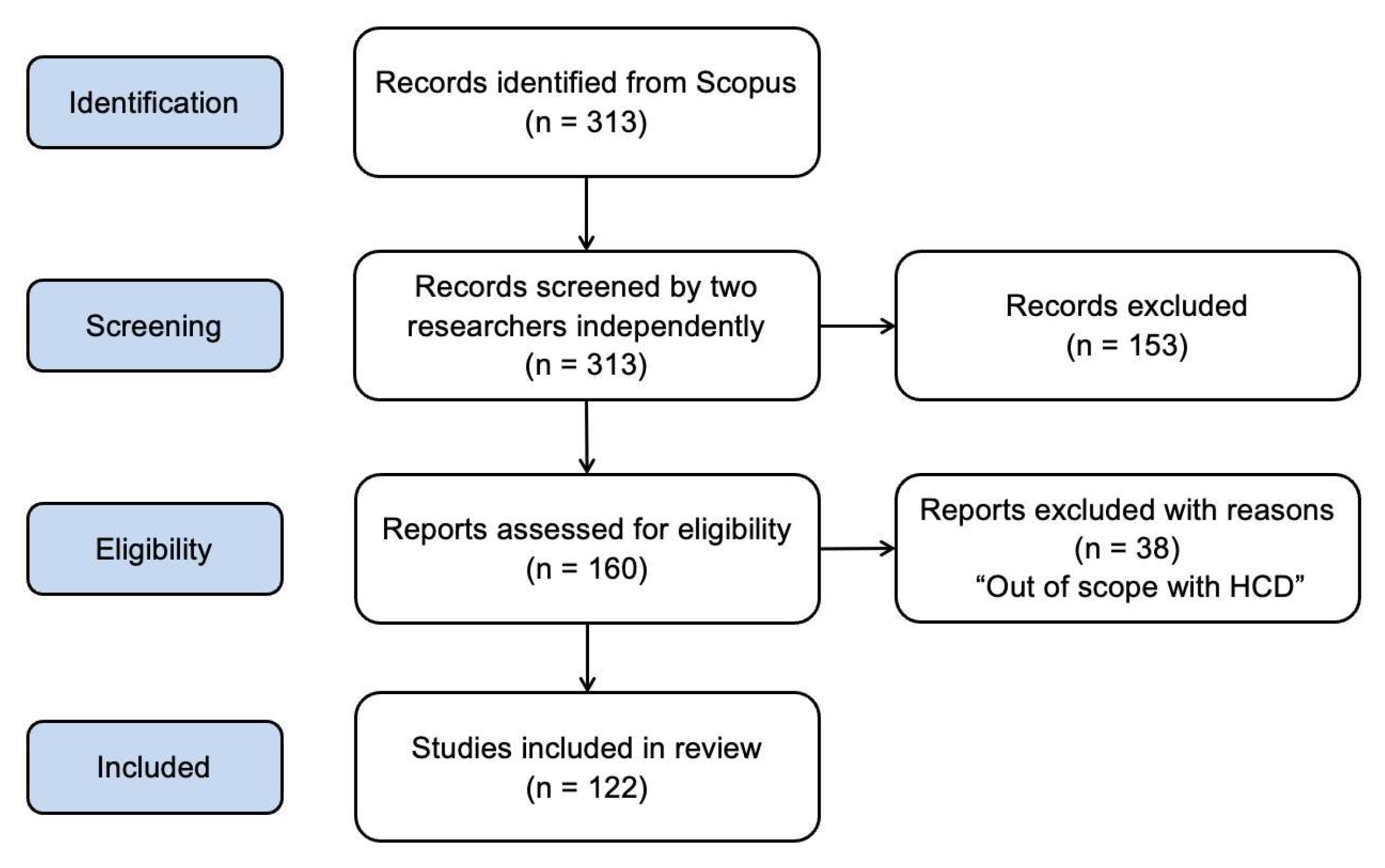
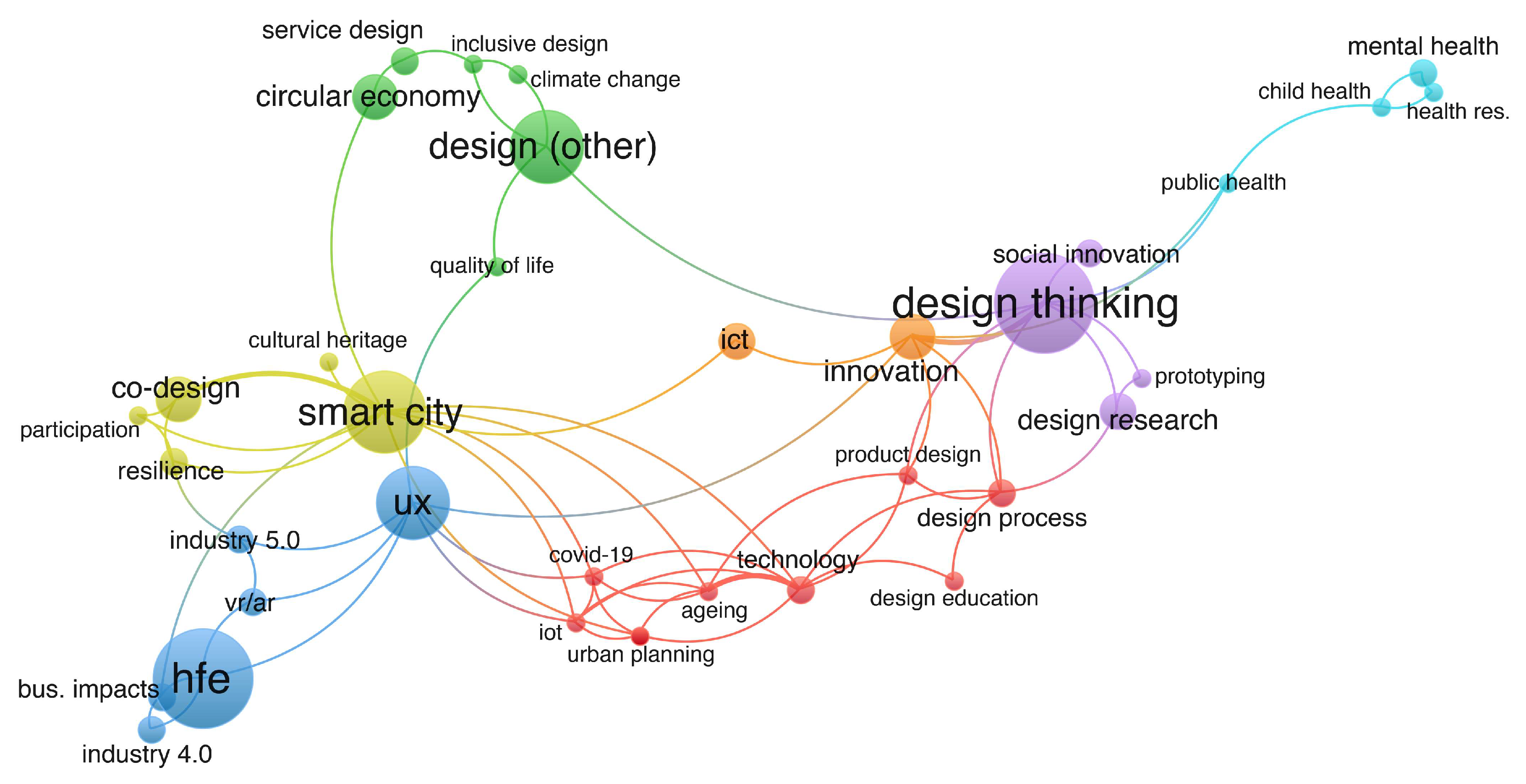
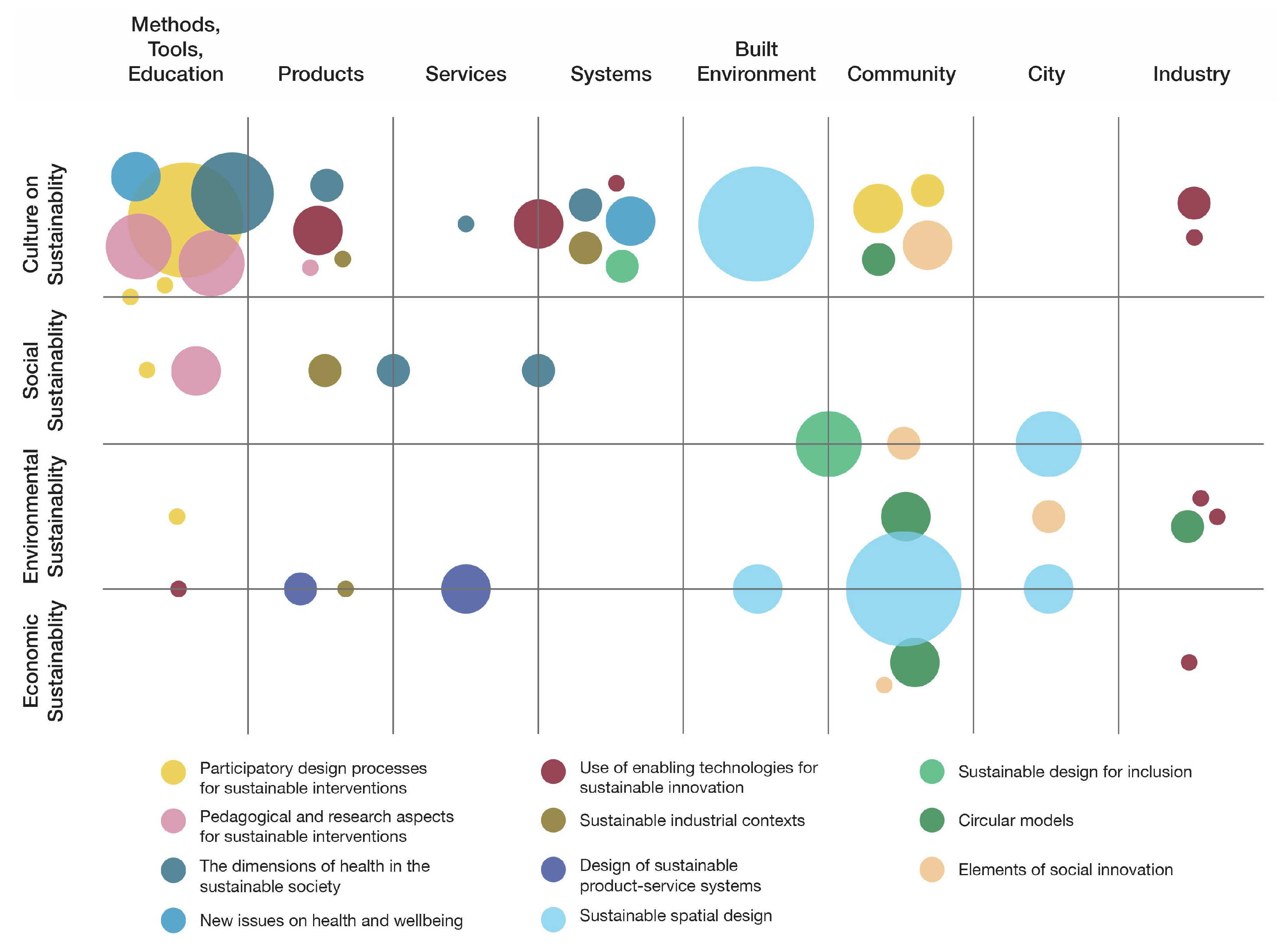
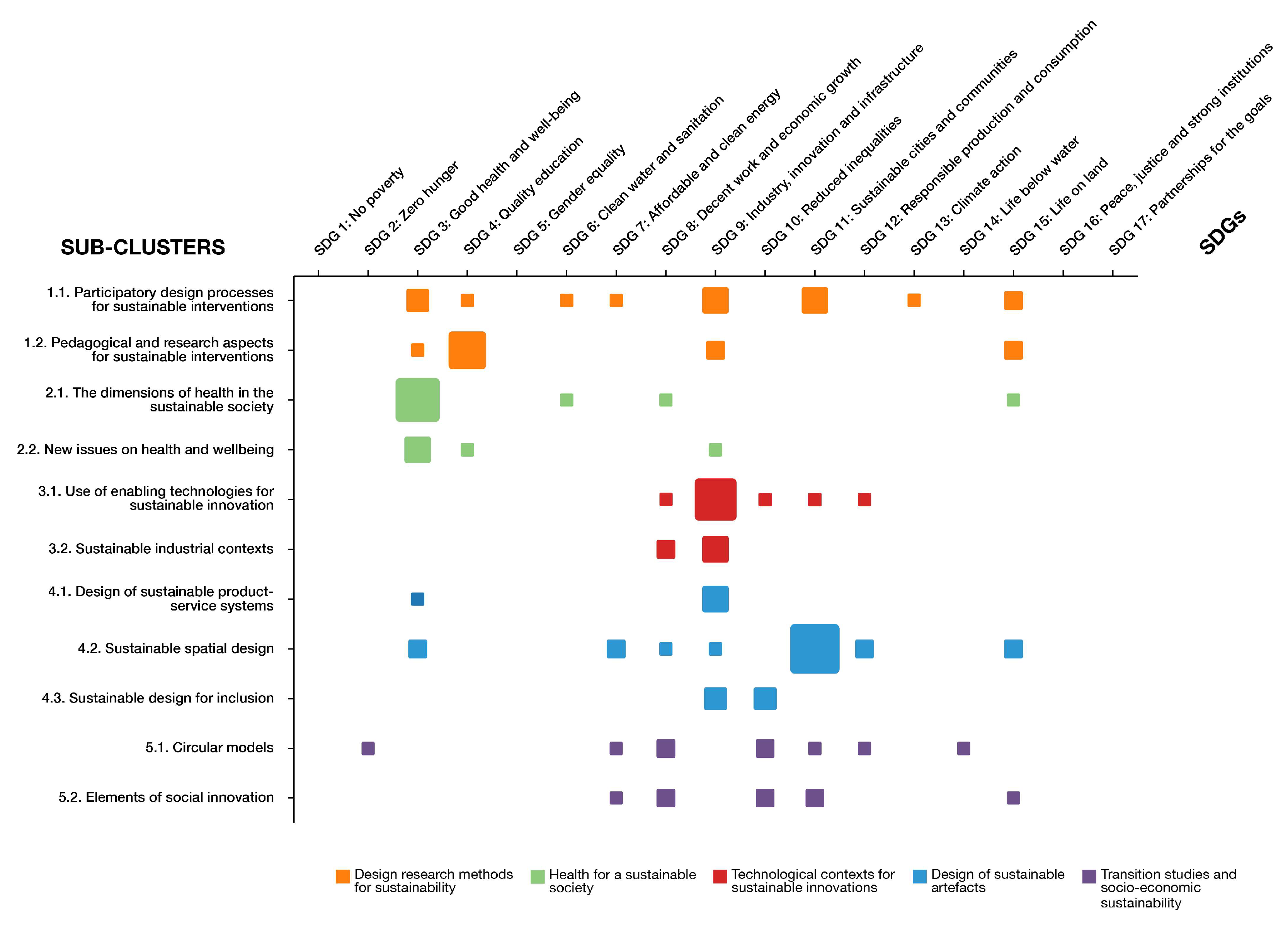
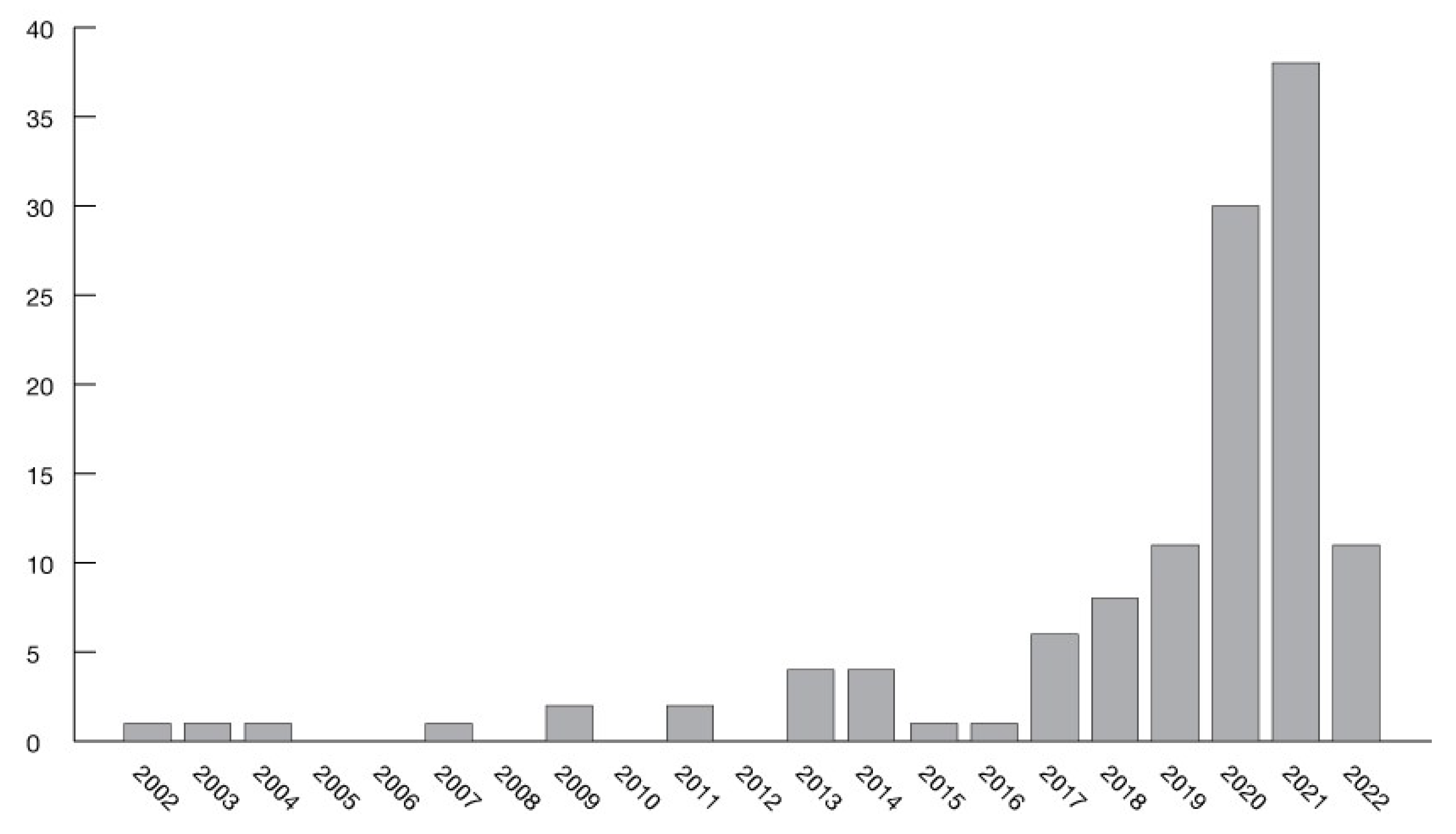
| Groups | Keywords |
|---|---|
| Red | Design process (3), Technology (3), Ageing (2), COVID-19 (2), Design education (2), IoT (2), Product design (2), Urban planning (2) |
| Green | Design (other) (8), Circular economy (5), Service design (3), Climate change (2), Inclusive design (2), Quality of life (2) |
| Dark Blue | HF/E (11), UX design (8), Business impacts (3), Industry 4.0 (3), Industry 5.0 (3), VR/AR (3) |
| Yellow | Smart city (9), Co-design (5), Resilience (3), Cultural heritage (2), Participation (2) |
| Purple | Design thinking (11), Design research (4), Social innovation (3), Prototyping (2) |
| Light Blue | Mental health (3), Child health (2), Health research (2), Public health (2) |
| Orange | Innovation (5), ICT (4) |
| Clusters | Sub-Clusters |
|---|---|
|
|
|
|
|
|
|
|
|
|
| Research Trajectories | Cluster 1 | Cluster 2 | Cluster 3 | Cluster 4 | Cluster 5 |
|---|---|---|---|---|---|
| Reducing inequalities by improving socio-economic driving forces for sustainable transitions | X | x | X | ||
| Innovative education to trigger the economic prosperity | X | x | x | ||
| Generating radical innovations in the food systems at all scales | x | X | x | x | |
| The inclusive role of gender in the sustainable society | X | x | |||
| Health for All | x | X | x | ||
| Aware use and consumption of natural resources | X | x | |||
| Getting closer production and distribution systems to living environments | x | X | x | ||
| Working safely | X | x | x | ||
| Proactive sustainable living scenarios | x | X | x | ||
| Sustainable human-centered systems and sets of solutions | x | X | x | ||
| Development of wealthy communities | x | x | X | ||
| Supporting the transition toward a more democratic and fair society | x | X | |||
| Fostering the cooperation for the sustainable transition | x | x | x | x | X |
Disclaimer/Publisher’s Note: The statements, opinions and data contained in all publications are solely those of the individual author(s) and contributor(s) and not of MDPI and/or the editor(s). MDPI and/or the editor(s) disclaim responsibility for any injury to people or property resulting from any ideas, methods, instructions or products referred to in the content. |
© 2023 by the authors. Licensee MDPI, Basel, Switzerland. This article is an open access article distributed under the terms and conditions of the Creative Commons Attribution (CC BY) license (https://creativecommons.org/licenses/by/4.0/).
Share and Cite
Rossi, E.; Attaianese, E. Research Synergies between Sustainability and Human-Centered Design: A Systematic Literature Review. Sustainability 2023, 15, 12884. https://doi.org/10.3390/su151712884
Rossi E, Attaianese E. Research Synergies between Sustainability and Human-Centered Design: A Systematic Literature Review. Sustainability. 2023; 15(17):12884. https://doi.org/10.3390/su151712884
Chicago/Turabian StyleRossi, Emilio, and Erminia Attaianese. 2023. "Research Synergies between Sustainability and Human-Centered Design: A Systematic Literature Review" Sustainability 15, no. 17: 12884. https://doi.org/10.3390/su151712884
APA StyleRossi, E., & Attaianese, E. (2023). Research Synergies between Sustainability and Human-Centered Design: A Systematic Literature Review. Sustainability, 15(17), 12884. https://doi.org/10.3390/su151712884






